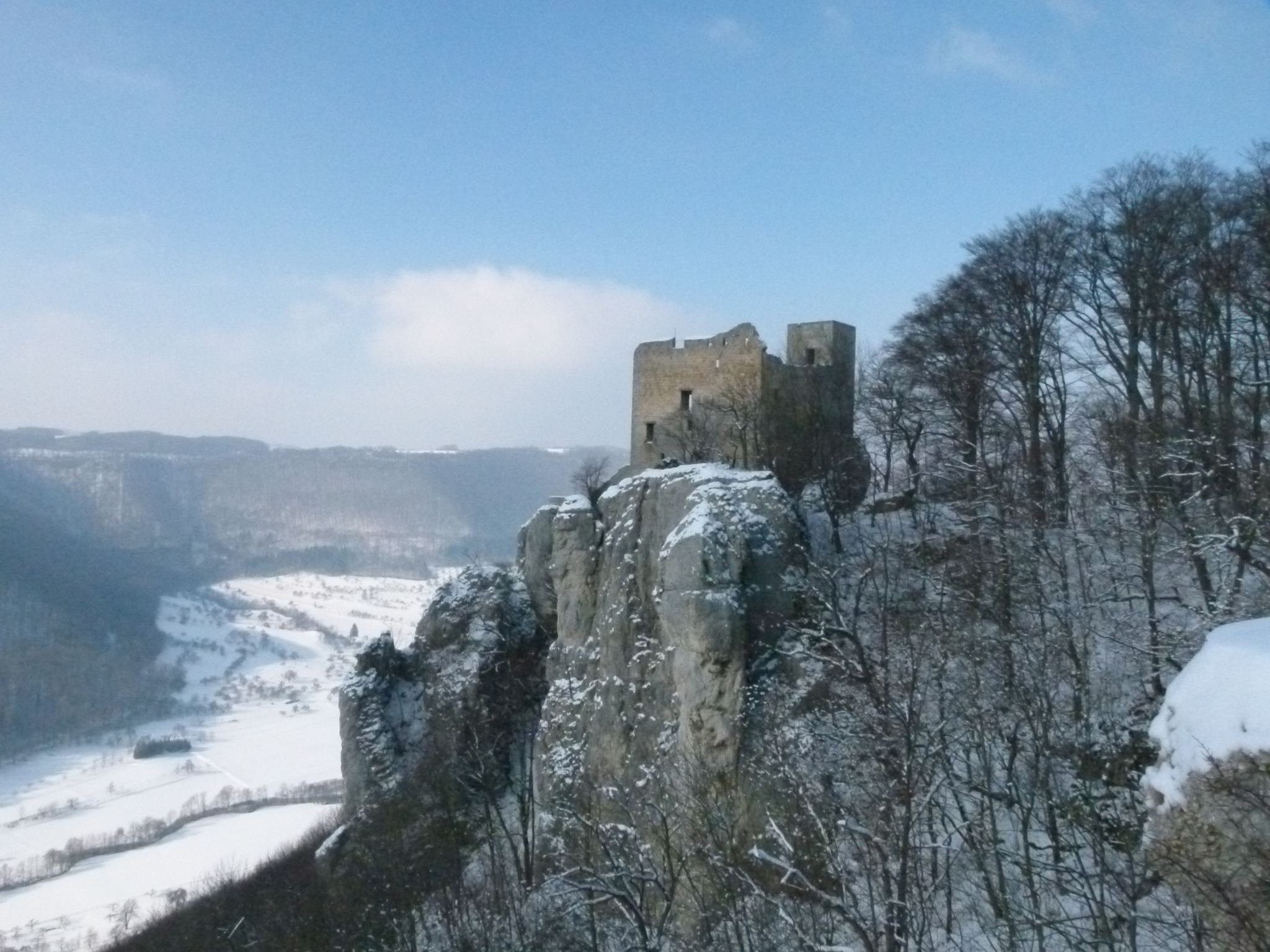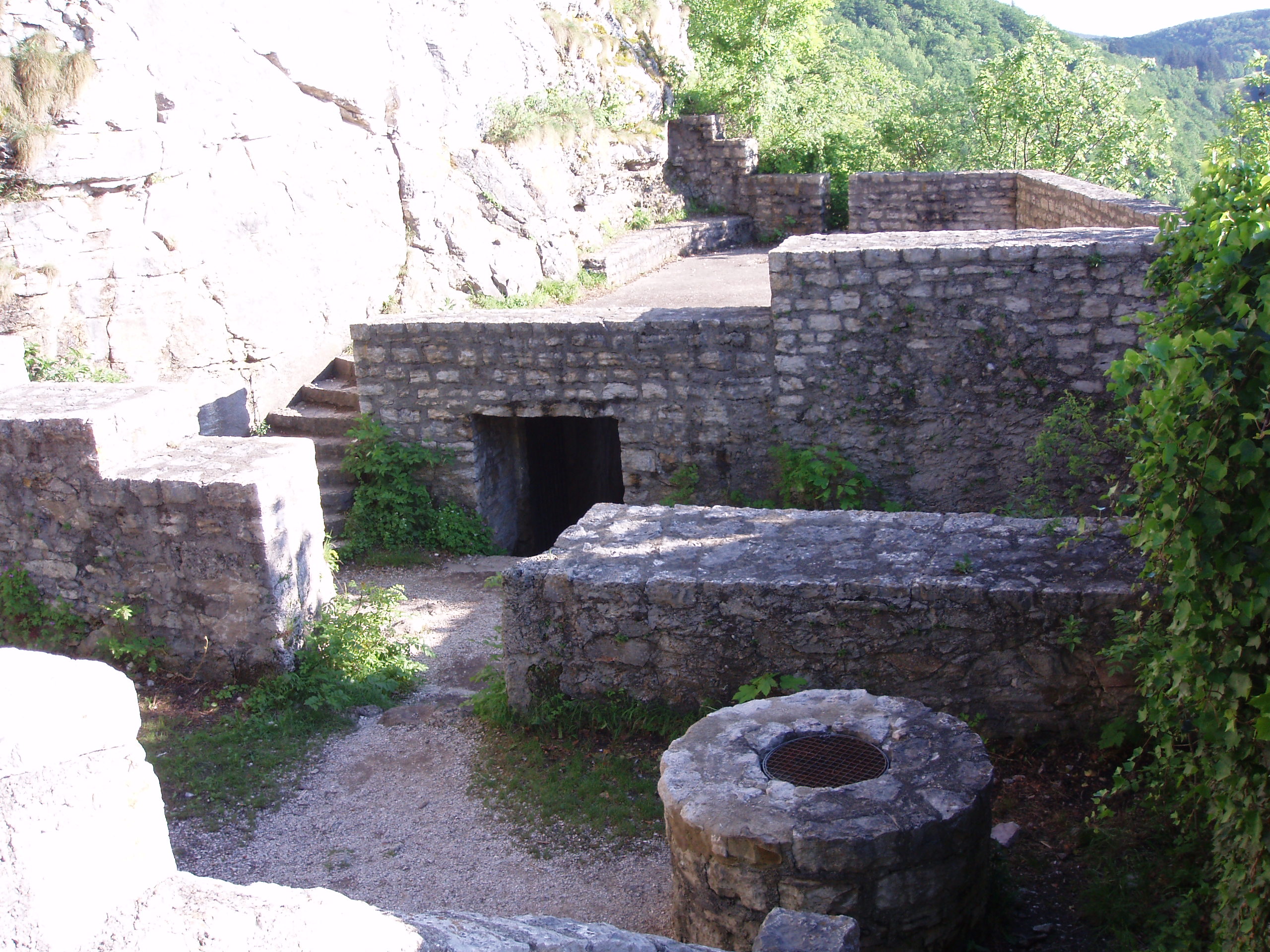Reussenstein Castle on:
[Wikipedia]
[Google]
[Amazon]

 Reussenstein Castle (Ruine Reußenstein: the Reussenstein Ruin) is ruins of a medieval fortress in
Reussenstein Castle (Ruine Reußenstein: the Reussenstein Ruin) is ruins of a medieval fortress in
 A legend about the origins of the castle was written by Wilhelm Hauff. The legend states that the castle was founded by a giant who had lived in a cave on the opposite side of the valley. In order to arrive at the building site, the giant only had to cross the valley with one large step. However, he did not step far enough and was left with a foot stuck in the marshy valley floor. When he pulled his foot out again, a spring rose from the footprint, which created the Lindach river.
Later, the castle was finished, except for one last nail. However, none of the craftsman dared to hammer in this final nail at such a height. There was only one young craftsman from the Neidlingen valley who dared to try. The giant held the young man to the window over the abyss, until he had finished the work. The craftsman was rewarded with riches and with the hand of the master builder's daughter in marriage.
A legend about the origins of the castle was written by Wilhelm Hauff. The legend states that the castle was founded by a giant who had lived in a cave on the opposite side of the valley. In order to arrive at the building site, the giant only had to cross the valley with one large step. However, he did not step far enough and was left with a foot stuck in the marshy valley floor. When he pulled his foot out again, a spring rose from the footprint, which created the Lindach river.
Later, the castle was finished, except for one last nail. However, none of the craftsman dared to hammer in this final nail at such a height. There was only one young craftsman from the Neidlingen valley who dared to try. The giant held the young man to the window over the abyss, until he had finished the work. The craftsman was rewarded with riches and with the hand of the master builder's daughter in marriage.
Reussenstein Castle website
*
* Photo of Reussenstein Castle in the German Wikipedia * * {{Authority control Ruined castles in Germany Swabian Jura

Germany
Germany,, officially the Federal Republic of Germany, is a country in Central Europe. It is the second most populous country in Europe after Russia, and the most populous member state of the European Union. Germany is situated betwe ...
. It is situated above sea level overlooking Neidlingen
Neidlingen is a municipality in the district of Esslingen, in Baden-Württemberg, Germany.
History
In 1807, Neidlingen, formerly a possession of the Kingdom of Bavaria, was assigned to the district of Wiesensteig in the Kingdom of Württemberg. ...
in Baden-Württemberg
Baden-Württemberg (; ), commonly shortened to BW or BaWü, is a German state () in Southwest Germany, east of the Rhine, which forms the southern part of Germany's western border with France. With more than 11.07 million inhabitants across a ...
, Germany
Germany,, officially the Federal Republic of Germany, is a country in Central Europe. It is the second most populous country in Europe after Russia, and the most populous member state of the European Union. Germany is situated betwe ...
.
History
The castle was built in 1270 as a ministerial castle of the Dukes ofTeck Teck may refer to:
* Teck Castle (Burg Teck) in Württemberg, Germany
* Teckberg, mountain on which it is located
* Duke of Teck, a title of nobility, associated with Teck Castle
* Teck Railway, Germany
* Teck Resources, a Canadian mining company ...
in order to watch the only pass into the Swabian Alb
The Swabian Jura (german: Schwäbische Alb , more rarely ), sometimes also named Swabian Alps in English, is a mountain range in Baden-Württemberg, Germany, extending from southwest to northeast and in width. It is named after the region of ...
from the Neidlingen valley.
The knight Diethoh of Kirchheim-Stein was the first known castellan, from approximately 1301. His son sold it to his cousins, Konrad and Heinrich Reuss. The castle was named Reussenstein after this family in 1371.
In the following 50 years, the castle passed through 11 different owners, including the Dukes of Württemberg
Duke is a male title either of a monarch ruling over a duchy, or of a member of royalty, or nobility. As rulers, dukes are ranked below emperors, kings, grand princes, grand dukes, and sovereign princes. As royalty or nobility, they are ranked ...
in 1381. In 1441, the Counts of Helfenstein took possession. The last to live in the castle was Ludwig Helferich of Reussenstein. With the end of the Helfensteins in 1550, the castle became uninhabited and fell into disrepair.
In 1752, it was acquired by the Bavarian Court, but in 1806 became the property of the State of Württemberg
Württemberg ( ; ) is a historical German territory roughly corresponding to the cultural and linguistic region of Swabia. The main town of the region is Stuttgart.
Together with Baden and Hohenzollern, two other historical territories, Würt ...
. In 1835 King William I of Württemberg
King is the title given to a male monarch in a variety of contexts. The female equivalent is queen, which title is also given to the consort of a king.
*In the context of prehistory, antiquity and contemporary indigenous peoples, the tit ...
gave the castle to his adjutant Colonel von Fleischmann.
In 1846, the last lynx in Germany was hunted in these ruins.
In 1862, the Württemberg royal estates office took over the administration of the castle, which remained in the possession of the former royal family of Württemberg until 1964.
Throughout 1965–1966 the castle was restored by the district of Nürtingen
Nürtingen () is a town on the river Neckar in the district of Esslingen in the state of Baden-Württemberg in southern Germany.
History
The following events occurred, by year:
*1046: First mention of ''Niuritingin'' in the document of Speyer. ...
, now included in the district of Esslingen, under the supervision of the Baden-Württemberg Historical Monuments Department.
Legend
 A legend about the origins of the castle was written by Wilhelm Hauff. The legend states that the castle was founded by a giant who had lived in a cave on the opposite side of the valley. In order to arrive at the building site, the giant only had to cross the valley with one large step. However, he did not step far enough and was left with a foot stuck in the marshy valley floor. When he pulled his foot out again, a spring rose from the footprint, which created the Lindach river.
Later, the castle was finished, except for one last nail. However, none of the craftsman dared to hammer in this final nail at such a height. There was only one young craftsman from the Neidlingen valley who dared to try. The giant held the young man to the window over the abyss, until he had finished the work. The craftsman was rewarded with riches and with the hand of the master builder's daughter in marriage.
A legend about the origins of the castle was written by Wilhelm Hauff. The legend states that the castle was founded by a giant who had lived in a cave on the opposite side of the valley. In order to arrive at the building site, the giant only had to cross the valley with one large step. However, he did not step far enough and was left with a foot stuck in the marshy valley floor. When he pulled his foot out again, a spring rose from the footprint, which created the Lindach river.
Later, the castle was finished, except for one last nail. However, none of the craftsman dared to hammer in this final nail at such a height. There was only one young craftsman from the Neidlingen valley who dared to try. The giant held the young man to the window over the abyss, until he had finished the work. The craftsman was rewarded with riches and with the hand of the master builder's daughter in marriage.
External links
*Reussenstein Castle website
*
* Photo of Reussenstein Castle in the German Wikipedia * * {{Authority control Ruined castles in Germany Swabian Jura